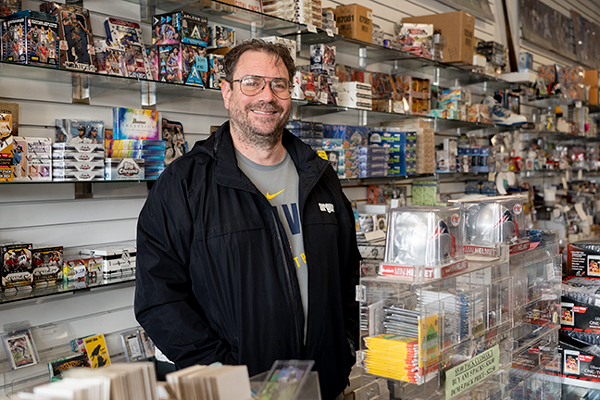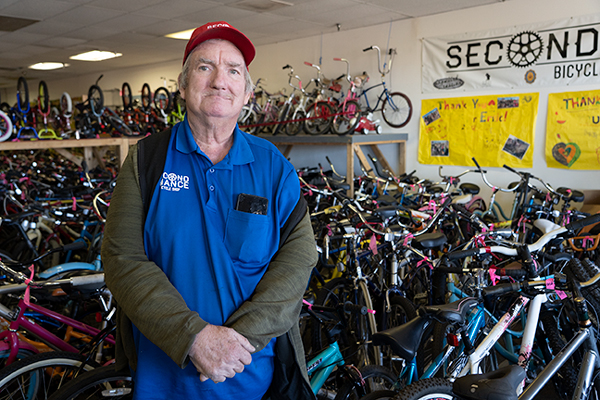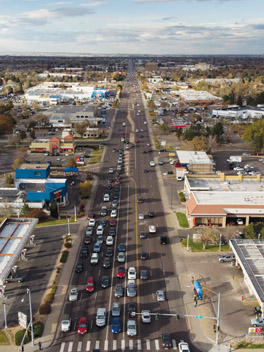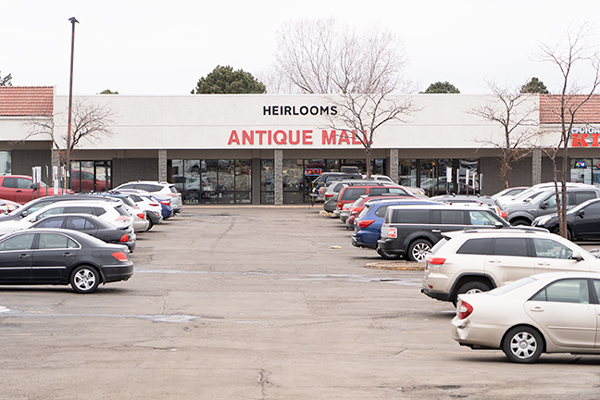


Mike Fruitman has been slinging sports memorabilia out of his current spot in the East Bank Shopping Center “since the Broncos won the Super Bowl.”
Before that, he spent around a dozen years in another spot at the center — all told, Mike’s Stadium Sportscards has called East Bank home for about 20 years.
“I was attracted by the traffic flow that went by on Parker Road,” Fruitman said. Plus, he said he liked the restaurants that shared the center, and he lives just a short drive away.
Homes, condominiums and other low-rise commercial buildings surround the southwest Aurora shopping center at Parker and Quincy on three sides. Cherry Creek State Park sprawls off to the west. The East Bank Shopping Center was built at the start of the 1980s as shopping malls across the country roared into their golden age.
In 1985, writer William Kowinski declared that malls were “the new Main Streets of America,” and by 1987, more than half of all retail sales were transacted at a shopping mall, according to researchers Richard Feinberg and Jennifer Meoli.
Tausha Wells and a business partner took the plunge and opened their own pet supply store, Pet Palace, at East Bank in 1993.
“I’m not saying it’s not scary, but when you’re young, you just say, ‘You know what, we’re going for it,’” Wells said. “We looked at different locations, and at the time, East Bank seemed like a pretty active mall.”
As Fruitman’s and Wells’ businesses built steam, they shared the center with big-name businesses like Albertsons, Kmart and 24 Hour Fitness. Those tenants filled larger storefronts in the mall and served as “anchors” driving traffic to smaller businesses.
But over the following decades, the rise of online shopping and other trends in consumer behavior would decimate retail giants and pose new challenges for brick-and-mortar shopping centers, including East Bank.
The coup-de-grace for many struggling retail storefronts turned out to be the COVID-19 pandemic. Spots at East Bank that once housed anchor tenants were vacant by the end of 2020.
“I don’t know when it began, but I began to have my doubts about this shopping center when a Subway location and a liquor store closed,” Fruitman said. “You’ve got some businesses that typically don’t go out of business that have failed.”
Mayor Mike Coffman dubbed the center “blighted” at a Feb. 14 city council hearing. Members were deliberating on a proposal to redevelop the shopping center. Marcus Pachner, a consultant for the redevelopment project, said East Bank was “a revolving door of retail instability.”
At the hearing, Pachner described plans to replace part of the center with an apartment complex, reorganizing the mall around a new “residential anchor.”
“What makes these centers actually work are anchors,” Pachner said. “There is no doubt that a dying center is the worst thing that can happen to those businesses.”
The proposal has generated ire, meanwhile, among nearby residents, who have raised a multitude of objections, including saying the project sponsors haven’t done enough for existing small businesses.
Pet Palace would be displaced by the redevelopment. Wells said they have signed a letter of intent to relocate into the spot currently occupied by Second Chance Bicycle Shop, which would boot the bike shop out of the center.
“It’s sad to say, but if we can’t find another building, we might just close it all down,” said Ernie Clark, the founder of Second Chance, which has been located in the center for close to four years. “Nobody knows what’s going to happen.”
And East Bank isn’t alone in its predicament.

The questions of what makes contemporary shopping centers successful and what should be done to redevelop aging malls aren’t new, but they’re especially urgent in light of the rise of online retail and the COVID-19 pandemic.
Considering sales tax collections across Colorado, Kevin Hougen, president of the Aurora Chamber of Commerce, said around 10% of purchases were being made online prior to the pandemic. Now, he said some Colorado communities are seeing as much as 40% of all sales tax collected on online purchases.
Hougen said cities once viewed malls as more rewarding than other types of commercial and industrial development because of their ability to churn out sales tax. Now, Aurora’s brick-and-mortar businesses have to contend with competition from online retailers such as Amazon.
“On Colfax, when the malls started opening, we went from Main Street to malls, and now we’re going to mail,” Hougen said. “I think e-commerce is a wonderful tool, but we’re just starting to recognize some of the consequences of it.”
COVID-19 accelerated the turn toward e-commerce, Hougen said, while additionally threatening non-retail businesses like restaurants.
He also said more people working from home means fewer customers out and about during what used to be peak shopping hours.
Jon Zhang, a Colorado State University professor whose research focuses on the future of physical retail storefronts, noted that it’s often easier for consumers to buy things from the comfort of their homes.
“You can fulfill the transactional need more easily online,” he said. “Even before the pandemic, there was a shift away from strip malls. The pandemic just made it even more miserable.”

One direction redevelopment could take is housing, Zhang said. Especially in urban areas where the inventory of housing is limited, sprawling commercial centers can be built upward into residential or mixed-use developments.
That’s consistent with the new vision for East Bank, which would replace about 95,000 square feet in the northeast corner of the shopping center with a four-story, 311-unit apartment complex and parking garage. Pachner described the project as “mixed-use” to the City Council, bringing up how the apartments were envisioned to complement the existing shops.
“I’m glad that some strip malls are turning into housing,” Zhang said. “It’s a lot of real estate. Shifting that access from retail to fill the need for housing … it’s expensive, but I think it could make sense.”
“You’re seeing it all over,” Hougen said of shopping centers being redeveloped into housing.
Hougen mentioned a proposal to transform part of Englewood’s city hall and the CityCenter Englewood retail complex, formerly the Cinderella City mall, into apartments serving the south Denver suburb. According to reporting last year by the Englewood Herald, the plan would also add hotel and office space to the struggling center.
Besides being reconfigured into housing, Zhang said shopping centers could also cater to new trends in consumer behavior by focusing on offering an “experience” to customers rather than just products which could easily be purchased online.
“Retail stores have to reinvent to be more experiential and immersive,” Zhang said. “Even Walmart and Target are trying to be more experiential.”
Big box retailers like Target, Kohls and Walmart have in-store speciality shops, such as Ulta or Claires.
More reasons to turn out in person includes entertainment above and beyond the movie theaters and bowling alleys of yore — Hougen mentioned the multi-purpose FieldhouseUSA gymnasium at Town Center at Aurora as an example of a new, non-retail draw for mall visitors.
The indoor sports facility opened in 2021 and took the place of a derelict Sears in the storied mall near Interstate 225 and Alameda.
In Greenwood Village, Pindustry opened last year, bringing bowling, arcade games and craft beer together under the roof of what used to be a used car business in a suburban shopping center.
“They’ve become a little bit like entertainment districts along with the shopping,” Hougen said of modern-day malls. “I think the entertainment aspect is happening right in front of us.”

North and west of East Bank, much of the Havana Street corridor in Aurora is flanked by low-rise shopping centers. They’re home to an eclectic and diverse mix of businesses, from bars and restaurants to car dealerships, bingo parlors, marijuana dispensaries, small markets and more.
Chance Horiuchi, executive director of the Havana Business Improvement District, said the strip malls of Havana Street are holding their own against the retail apocalypse. In fact, she said they’re “thriving,” with around 95% of space in shopping centers filled as of late 2021.
Horiuchi said she didn’t know the “secret sauce” that’s fueled commerce along Havana while other retail centers have struggled. But she described visitors traveling from out of town to patronize storefronts.
“Our businesses are destinations,” she said. “People drive from all over to go to the little shopettes on Havana that serve Korean dumplings or halal foods.”
Ethiopian, Eritrean, Mexican, Salvadoran, Indian, Chinese and Italian food are also served on the strip. Horiuchi said more than 20 international markets are located along Havana.
She said the diversity of cultures and industries contributes to the experience of shopping on Havana — an experience that appears to be valuable for those continuing to spend money within the district.
Scott Davenport runs an antiques store in Havana Plaza, in between an Ethiopian restaurant and an Eastern European deli. Davenport and Heirlooms Antique Mall have been in the center for about six and a half years, selling everything from books and vinyl records to skulls.
“There’s nothing you can’t get here,” Davenport said of the business community on Havana. “I’m probably four times busier than when I bought the place. … It’s just gotten busier and busier all the time.”
Zhang said successful centers tend to be located centrally, with storefronts close to and facing the main road. He also said businesses that offer significant in-person shopping experiences — including stores that sell things like clothing and furniture, which people are less comfortable buying sight unseen — could be more likely to survive.

Redevelopments such as the East Bank project require developers to strike a balance between innovation and preserving what makes a center, or a neighborhood, special.
Many of the people who live near East Bank have spoken out against the redevelopment, criticizing the apartment building’s proposed length, the potential impact on traffic and what it could mean for tenants like Pet Palace and Second Chance.
Wells said she learned about the redevelopment that would force her store to relocate from neighbors, not Kimco, their landlord of almost three decades.
While Pet Palace has signed the letter of intent that could pave the way for them to move into another space, she expressed skepticism about the ability of a residential anchor like the proposed 311 apartments to rally new business in the center.
“Our business has done well through all of the changes,” she said. “How long would it take to fill an apartment building? I’m not sure … but the businesses that are here have been here for a while.”
Fruitman was more optimistic.
“It has been a while since we’ve had a new population in this area, and it will be a great addition for my business,” he told the City Council at its meeting on Feb. 14. “As a resident, I’m always hopeful that a new project meets the needs for middle-level housing (that) metro Denver needs so desperately.”
Council members decided to delay a decision on the project, giving the sponsors of the redevelopment more time to work with tenants who would be impacted. The sponsors say they have been in regular communication with tenants and neighbors, and Pachner told the council that the neighbors had “influenced the design of every edge of this building.”

Both Wells and Fruitman credited their success to a loyal customer base, who have continued supporting their stores, even after the anchors tenants left East Bank.
On the topic of redevelopments, Zhang said developers could always invest in renovating struggling retail centers while leaving the underlying model of retail anchors and tenants intact. But he said he wasn’t sure if that is “a durable long-term proposition.”
“The big picture is consumer behaviors have shifted,” he said.
Zhang also suggested local governments take a hard look at local demand and the market before greenlighting more retail shopping centers that could go vacant.
Wells and Hougen both encouraged residents to shop local and patronize local brick-and-mortar businesses specifically.
Hougen acknowledged that online shopping is here to stay but said that, in general, he’s concerned about the future of physical retail in the city.
“I think it’s a needed service, but boy am I worried about our brick and mortar,” he said.
